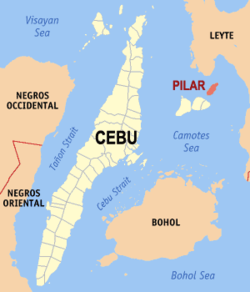Pilar | |
|---|---|
| Municipality of Pilar | |
 Map of Cebu with Pilar highlighted | |
Location within the Philippines | |
| Coordinates: 10°48′25″N124°33′54″E / 10.807°N 124.565°E | |
| Country | Philippines |
| Region | Central Visayas |
| Province | Cebu |
| District | 5th district |
| Barangays | 13 (see Barangays) |
| Government | |
| • Type | Sangguniang Bayan |
| • Mayor | Manuel P. Santiago (One Cebu) |
| • Vice Mayor | Chiziline S. Maratas (One Cebu) |
| • Representative | Vincent Franco D. Frasco (One Cebu) |
| • Municipal Council | Members |
| • Electorate | 9,607 voters (2025) |
| Area | |
• Total | 32.42 km2 (12.52 sq mi) |
| Elevation | 19 m (62 ft) |
| Highest elevation | 615 m (2,018 ft) |
| Lowest elevation | 0 m (0 ft) |
| Population (2024 census) [3] | |
• Total | 12,454 |
| • Density | 380/km2 (990/sq mi) |
| • Households | 3,360 |
| Economy | |
| • Income class | 5th municipal income class |
| • Poverty incidence | 45.33 |
| • Revenue | ₱ 79.24 million (2021) |
| • Assets | ₱ 271.1 million (2021) |
| • Expenditure | ₱ 66.68 million (2021) |
| • Liabilities | ₱ 103.6 million (2021) |
| Service provider | |
| • Electricity | Camotes Electric Cooperative (CELCO) |
| Time zone | UTC+8 (PST) |
| ZIP code | 6048 |
| PSGC | |
| IDD : area code | +63 (0)32 |
| Native languages | Cebuano Tagalog |
Pilar, officially the Municipality of Pilar (Cebuano : Lungsod sa Pilar; Tagalog : Bayan ng Pilar), is a municipality in the province of Cebu, Philippines. According to the 2024 census, it has a population of 12,454 people. [5]
Contents
The municipality is contiguous with Ponson Island, one of the four Camotes Islands in the Camotes Sea (along with Pacijan Island, Poro Island, and Tulang Island). The island is about 10.6 kilometres (6.59 mi) long and 3.7 kilometres (2.30 mi) wide.



